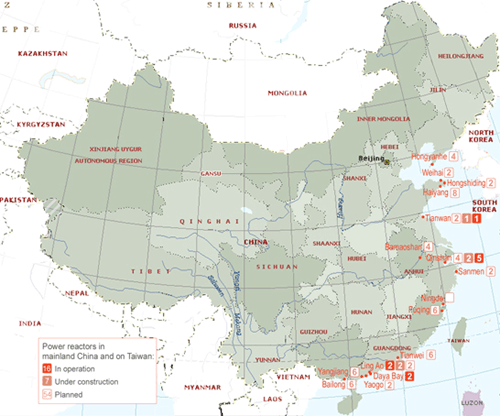Corruption, quality fears cloud China's nuclear programme
25 Mar 2011
Mainland China's notorious record of corruption and mismanagement in construction projects is causing grave concern about the safety of its nuclear programme. The concerns are mounting as China accounts for about half of the world's total of on-going and planned nuclear projects.
Though it has ordered a temporary freeze on all nuclear projects under construction, pending a safety review, the pressure on the communist regime to withdraw the moratorium would be intense given the insatiable appetite for power of a galloping economy.
China's twin horns of a dilemma in the energy sector are the facts that power consumption in the economy grew 14 per cent in 2010, according to the official Xinhua News Agency. Even as power consumption grows the regime is trying to discourage use of coal which is a huge source of pollution and leaves Beijing vulnerable to attacks around the globe about its commitment to controlling emissions.
In a bid to these challenges Beijing has pitched for nuclear power in a big way.
It now has 13 operating nuclear reactors, which produce nearly two per cent of its total power output. More important it has 27 more under construction. An incredible 50 more are planned and more than 100 proposals await sanction.

With such a massive commitment China is aiming to increase its nuclear generating capacity ten times by 2020.
In the wake of the nuclear accident at Fukushima, in Japan, Beijing called for a comprehensive safety check and revision of safety standards for all nuclear plants in China.
Under the review, power plants and other nuclear facilities that are operational, or under construction, are to be inspected. New, more evolved, standards of safety, however, will be imposed only on plants that have either not yet been approved or have not advanced beyond site preparation.
China has a variety of power plant designs in operation or under construction -French, Canadian, Russian and American. It also has a domestic design that is derived largely from French technology.
Evolving a safety policy that will have oversight over such a bewildering variety of designs and technologies is a very big challenge.
The biggest challenge, however, may arise from evils that have are now accepted facets of national life. Shoddy quality of public works, where funds are siphoned off to line the pockets of officials in power, has already had a deadly impact.
In the 2008 Sichuan earthquake, dozens of schools collapsed due to shoddy materials and construction, killing thousands of children.
In a major corruption scandal that is still unravelling contractors in the railway ministry used cheap chemical hardening agents for China's much-touted high-speed rail system. The hugely publicised fact that trains could run at speeds of 250 mph is now in doubt.
An utter disregard for human life also characterised the melamine-tainted baby formula scam that hit Chinese consumers in 2008.

.webp)




















